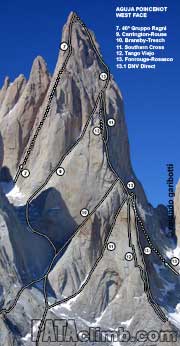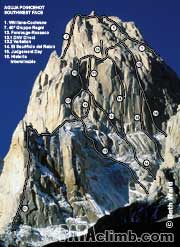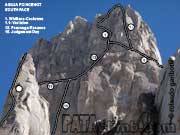Aguja Poincenot - Southwest face
13. Fonrouge-Rosasco
13.1 DNV Direct
13.2 Benedetti-DeGregori
13.3 Bransby-Tresch
700m 6c 60˚
José Luis Fonrouge and Alfredo Rosasco (Argentina), 24-27/12/1968.
Description. Climbs the left side of the SW face. The lower part follows a series of steps that are often iced up. The corner half way up the face is the crux of the climb, involving wide climbing that is followed by a series of gendarmes to a rappel and easier ground to join the Whillans-Cochrane route (900m altogether).
History. The first ascent was done alpine style over 4 days with a single sleeping bag between the two of them, which Fonrouge used... On the first pitch Fonrouge took a big fall, when two of the three pieces he had placed came out, but luckily the last one, an early version of a nut, held. During their descent they found themselves rappeling the crux of the route at night, where due to the large size cracks they had to rappel off a very poorly placed bong, which only by chance held. In 1994 Italianas Fabio Leoni and Ermanno Salvaterra made the second ascent of the route in 13 hours. They descended a line to the east of Historia Interminable, along which they had to place a couple of bolts when they found themselves in the middle of blank rock. After repeating the route Ermanno commented: “I was very impressed by the route. Fonrouge was a real visionary: climbing alpine style, in three days and with no stove this very long route. He approached first ascents in a way that unluckily not even today people do. If we compare ourselves to someone like Fonrouge we have to acknowledge the fact that we have not progressed very much.”
Approach. Polacos.
Descent. The first ascensionists descended the route, but it might be preferable to descend via Historia Interminable or Judgment Day. Plan on taking lots of cord and leaver gear.
Bibliography.
First ascent. AAJ 1969 p. 447; Anuario CAB 1979 p. 18; Fonrouge J.L. (1999) Horizontes Verticales en la Patagonia, El Elefante Blanco, Buenos Aires (p. 209-228).
Salvaterra. Alp 111 p. 18; AAJ 1995 p. 208; Rivista della Montagna 167 p. 8; Bolletino SAT 1994/2 p. 30-31.
|
Photos (click to enlarge)

Aguja Poincenot west face 
Aguja Poincenot southwest face 
Aguja Poincenot south face |
13.1 DNV Direct
600m 7a C1
Jason Kruk and Will Stanhope (western Canada), 1/2008.
Description. The route climbs the west pillar of Poincenot, climbing from its lowest point. The lower portion of the west pillar of Poincenot is composed of kitty-litter granite, Joshua Tree at its worst, but the quality of the rock improves greatly higher up. Half way up it joins the Fonrouge-Rosasco (1100m altogether).
History. The first ascentionists spent three days on the route: two on the way up, and one on the descent. The name stands after District of North Vancouver, the happy suburb where the first ascentionists grew up. A Polish team first attempted this line in 1986, the year Will Stanhope was born... The Polish who originally intended to attempt Cerro Torre’s South face managed to climb about 12 pitches, to the top a small tower, following a line similar and somewhat to the left of the DNV. The expedition was lead by Piotr Lutinsky, who curiously lives in Vancouver.
The Polacos camp located in the moraines some 100 meters above the Cerro Torre glacier is named after this expedition, in spite of the fact that it had been used many years before by an Argentinian expedition (Köpcke and co. late 1969).
Approach. Same as above.
Descent. The first ascentionists rappelled the Carrington-Rouse. |
13.2 Benedetti-DeGregori
In December 2010 Argentines Esteban Degregori and Nicolas Benedetti climbed six new pitches (200m 6c) to the right of the Fonrouge-Rosasco. After climbing the first two pitches of the Fonrouge they continued up where the route heads left, climbing a right to left system to rejoin the Fonrouge at the crux corner. They retreated after joining the Whillans, along which they rappelled.
|


